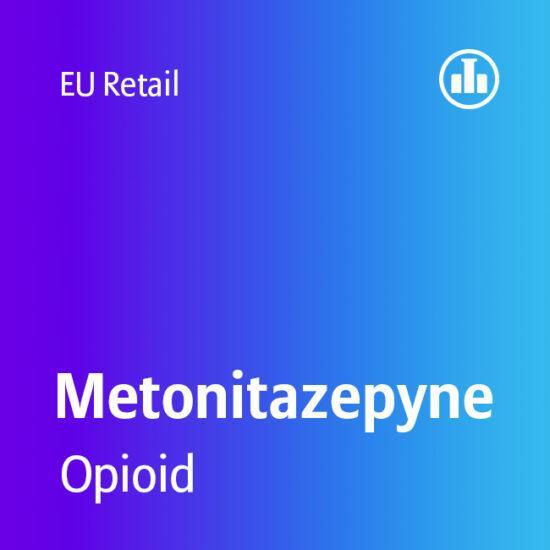SR-14968: A Comprehensive Technical Overview
Chemical Identity
- Nome IUPAC: 3-[1-[1-(4-bromophenyl)ethyl]piperidin-4-yl]-5,6-dichloro-1H-benzimidazol-2-one
- Fórmula molecular: C₂₀H₂₀BrCl₂N₃O
- Molar Mass: 469.20 g/mol
- Número CAS: 2133455-40-8
- PubChem CID: 130431386
Pharmacological Profile
SR-14968 is a synthetic compound classified as a G protein-biased agonist at the μ-opioid receptor (MOR). Unlike traditional opioids that activate both G protein and β-arrestin pathways, SR-14968 preferentially engages the G protein signaling cascade while exhibiting minimal recruitment of β-arrestin 2. This selective activation is associated with potent analgesic effects and a potentially improved side effect profile, particularly concerning respiratory depression and tolerance development.
Mecanismo de ação
The μ-opioid receptor is a G protein-coupled receptor (GPCR) that mediates the effects of endogenous opioids and opioid drugs. Upon activation by agonists, MOR can signal through two primary pathways:
- G Protein Pathway: Leads to analgesia and other therapeutic effects.
- β-Arrestin Pathway: Associated with adverse effects such as respiratory depression, constipation, and tolerance.
SR-14968 exhibits a strong bias towards the G protein pathway, thereby promoting analgesia while minimizing β-arrestin-mediated side effects. This bias is quantified by comparing the efficacy of the compound in activating G protein signaling versus β-arrestin recruitment.
Farmacodinâmica
- Analgesic Efficacy: In preclinical models, SR-14968 demonstrates potent antinociceptive effects. It effectively increases pain thresholds in assays such as the tail-flick and hot plate tests. Notably, its analgesic potency is comparable to that of morphine, with a potentially wider therapeutic window.
- Respiratory Effects: Traditional opioids often cause dose-dependent respiratory depression, a leading cause of opioid-related fatalities. SR-14968, due to its G protein bias, exhibits reduced respiratory suppression in animal studies. This property suggests a lower risk of respiratory compromise at therapeutic doses.
- Tolerance and Dependence: Chronic administration of opioids can lead to tolerance (requiring higher doses for the same effect) and physical dependence. SR-14968 has been shown to produce less tolerance development compared to morphine in certain pain models. However, it can still induce withdrawal symptoms upon abrupt cessation, indicating some potential for dependence.
Farmacocinética
While specific pharmacokinetic data for SR-14968 are limited, its structural properties suggest favorable absorption and distribution characteristics. The presence of lipophilic groups may facilitate blood-brain barrier penetration, essential for central analgesic effects. Metabolic pathways and elimination profiles remain to be fully elucidated.
Dosagem e administração
In preclinical studies, SR-14968 has been administered intraperitoneally in rodents at doses ranging from 0.3 to 3 mg/kg. The effective analgesic dose varies depending on the pain model and the species studied. Translating these doses to human equivalents requires careful consideration and further clinical research.
Efeitos secundários
While SR-14968 aims to reduce the side effect burden associated with traditional opioids, some adverse effects have been observed:
- Central Nervous System: At higher doses, SR-14968 can induce sedation and motor impairment.
- Gastrointestinal: Some studies report reduced gastrointestinal motility, though to a lesser extent than morphine.
- Dependence: Withdrawal symptoms have been noted upon discontinuation, indicating potential for physical dependence.
Harm Reduction Considerations
Given its opioid receptor activity, SR-14968 should be approached with caution:
- Monitoring: Users should be monitored for signs of respiratory depression, especially at higher doses.
- Titration: Doses should be titrated carefully to achieve the desired analgesic effect while minimizing side effects.
- Combination Therapy: Avoid combining SR-14968 with other central nervous system depressants, such as alcohol or benzodiazepines, to reduce the risk of additive respiratory depression.
- Withdrawal Management: Gradual tapering is recommended to mitigate withdrawal symptoms upon discontinuation.
Conclusão
SR-14968 represents a promising advancement in opioid pharmacotherapy, offering potent analgesia with a potentially improved safety profile. Its G protein-biased mechanism may reduce the incidence of severe side effects commonly associated with traditional opioids. However, further clinical studies are necessary to fully understand its pharmacokinetics, optimal dosing strategies, and long-term safety in humans.develop harm reduction strategies to ensure patient safety.
Porquê comprar SR-14968 UE da RECHEMCO?
Temos uma longa história de negociação no mercado, pelo que beneficia da nossa experiência.
★ SR-14968 foi testado e verificado.
Aceitamos vários métodos de pagamento, como Bitcoin, Monero e transferência bancária.
O que recebe quando compra SR-14968 da RECHEMCO?
- Um saco de folha de alumínio selado com um produto da mais alta qualidade SR-14968
• crystalline powder
- 99% Pureza






Avaliações
Ainda não existem avaliações.